Flowering shrubs create privacy while enhancing your yard’s beauty and ecosystem. Options like forsythia, hydrangeas, and privets grow quickly, offering seasonal interest through blooms, foliage, and winter features. For maximum impact, layer different heights and varieties, staggering your plantings in odd numbers for a natural look. Proper soil preparation and seasonal care guarantee dense growth and longevity. The right selection can transform your outdoor space into a secluded, wildlife-friendly retreat.
Benefits of Living Privacy Screens for Your Landscape
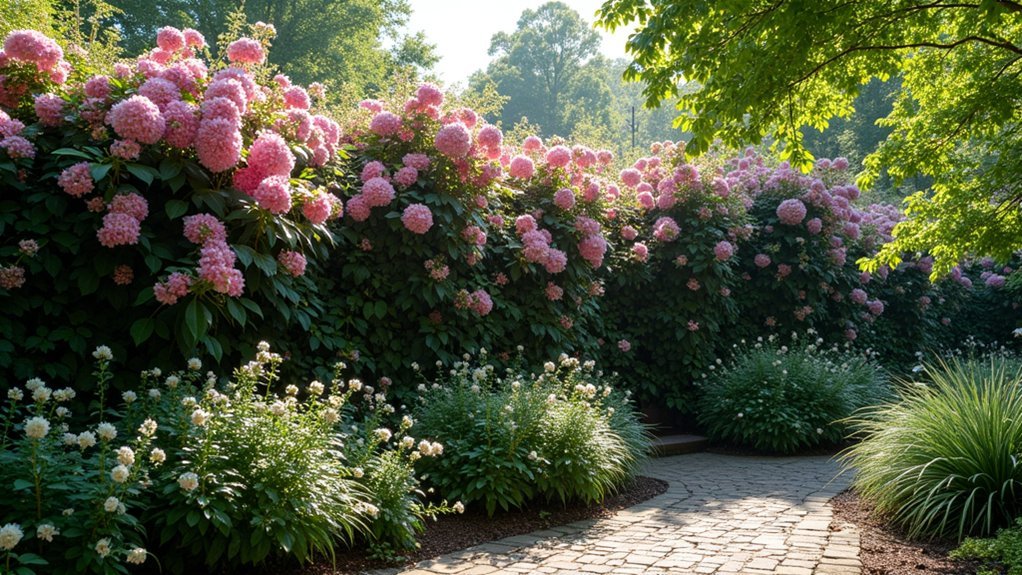
While traditional fencing offers basic boundary definition, living privacy screens transform your outdoor spaces into secluded retreats with multiple advantages.
You’ll enjoy enhanced privacy as dense foliage blocks sightlines from neighbors and discourages unwanted attention.
Beyond privacy, these natural barriers provide significant environmental benefits. They absorb urban noise, filter air pollutants, and create valuable wildlife habitat.
As windbreaks, they protect outdoor seating areas from harsh gusts while providing shade that lowers ambient temperatures. These screens can be customized to suit specific privacy needs regardless of your property size.
Living screens add year-round visual interest through seasonal changes in blooms, foliage texture, and color.
They’re often more cost-effective than hardscape alternatives while boosting property values through improved curb appeal.
The energy savings from shade-driven cooling near home foundations makes them both beautiful and practical investments for your landscape.
Top Flowering Shrubs That Grow Quickly for Privacy
Creating a natural privacy screen begins with selecting the right flowering shrubs that establish quickly. Forsythia offers bright yellow blooms in early spring and grows rapidly with minimal care.
Nature’s curtains unfold quickly with the right flowering shrubs—forsythia brings sunshine to your sanctuary with effortless grace.
For vibrant color year-round, consider Flame Willows, which can reach heights up to 30 feet while providing dense coverage. Hydrangeas provide both screening and beauty with varieties that grow 2-3 ft annually in the right conditions.
Privets excel in formal settings, responding well to shaping while growing up to several feet annually. The Seven-Son Flower delivers late-season interest with its white blooms followed by decorative fruit clusters.
For variegated foliage, Dappled Willow (Hakuro Nishiki) brings visual excitement to zones 4-9.
In shadier locations, Buckthorn creates an effective screen with its compact growth habit.
These fast-growing options all establish themselves within 1-3 seasons, giving you privacy sooner than you might expect.
How to Create a Multi-Season Blooming Boundary
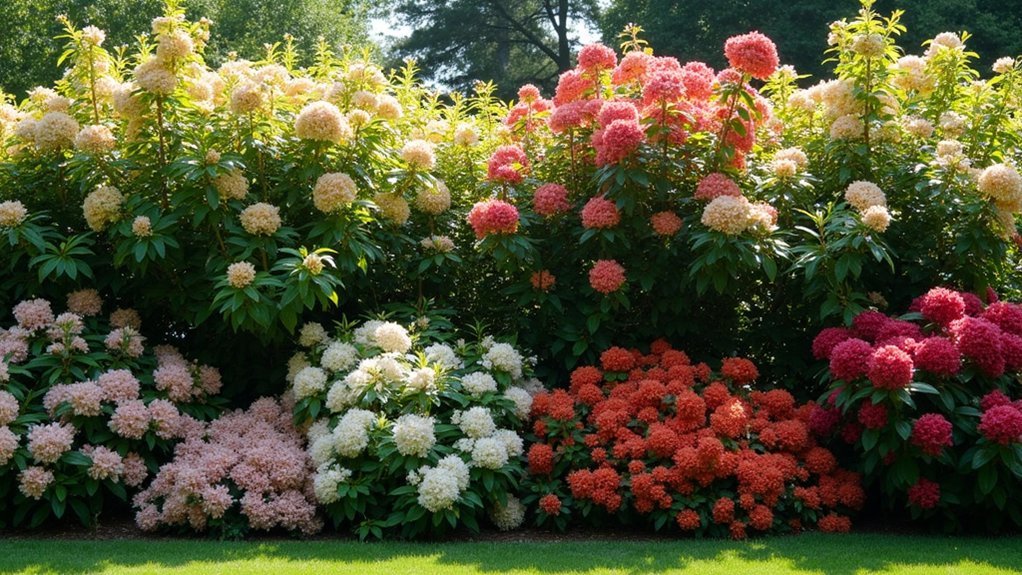
When planning a multi-season blooming boundary, the key lies in thoughtful plant selection and strategic arrangement. Choose shrubs with staggered blooming periods—like gardenias for summer fragrance, Carolina laurel for spring flowers, and shrubs with colorful winter branches.
Combine evergreens with deciduous varieties to maintain year-round structure while showcasing seasonal changes. Consider adding Nannyberry Viburnum for its exceptional adaptability across numerous growing zones.
- Mix plants with diverse flowering times, such as dwarf Korean lilac and dappled willow, to guarantee continuous color from spring through fall.
- Layer taller shrubs behind shorter ones for depth, creating both visual interest and effective screening.
- Incorporate shrubs with multi-season appeal—those offering fragrant blooms, vibrant foliage, and attractive berries or bark.
Remember to match your selections with your yard’s sunlight conditions and implement a regular maintenance schedule to keep your boundary looking its best.
Design Tips for Natural Privacy Hedges
Natural privacy hedges do more than simply block unwanted views—they transform your outdoor space into a living sanctuary. When designing your hedge, create a hand-drawn map of your yard and prioritize areas where privacy is most needed.
Choose a diverse mix of plants that will thrive in your climate and soil conditions. You’ll need to account for mature sizes and sunlight requirements to guarantee successful growth. Staggering your plantings in odd numbers creates a more natural and intentional appearance in your privacy screen.
| Design Element | Purpose | Implementation |
|---|---|---|
| Layered Planting | Visual depth | Combine tall, medium, and low plants |
| Mixed Species | Disease resistance | Include 3+ different plant varieties |
| Growth Rate Variety | Quicker coverage | Place fast-growers in priority areas |
| Seasonal Interest | Year-round appeal | Select plants with different bloom times |
| Maintenance Zones | Easier care | Group plants with similar needs together |
Regular pruning and a consistent care schedule will keep your living screen beautiful for years.
Best Hydrangea Varieties for Privacy Screening
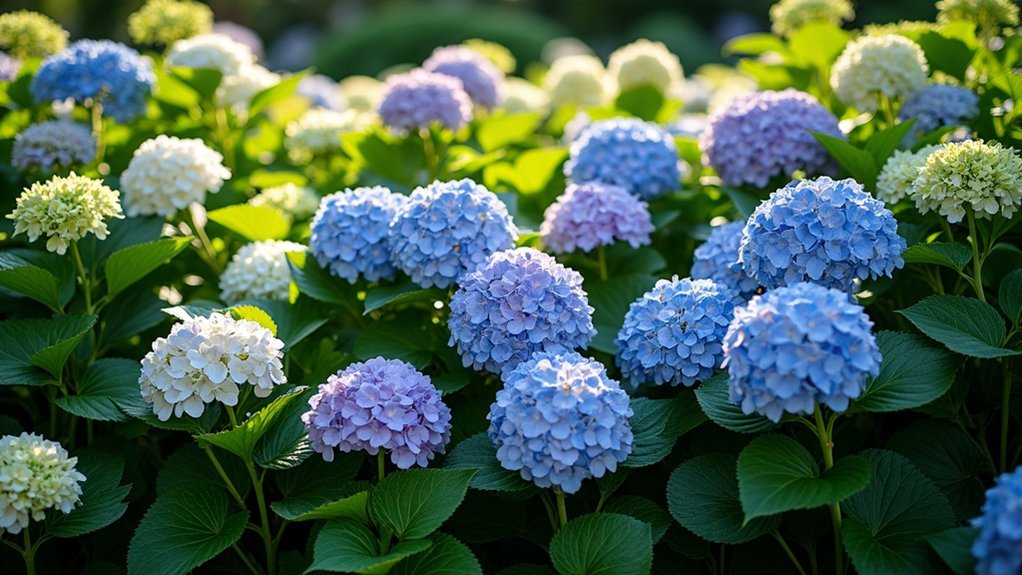
Hydrangeas stand among the most versatile flowering shrubs for privacy screens, offering both substantial height and spectacular blooms that transform ordinary boundaries into dramatic garden features.
Panicle varieties like ‘Limelight’ and ‘Pinky Winky’ reach impressive heights of 6-8 feet with annual growth of 1-2 feet, making them perfect for creating quick privacy barriers in full sun locations.
For lasting impact across seasons, consider:
- Oakleaf hydrangeas for shade areas with their distinctive foliage and exfoliating bark that provides winter interest
- Climbing hydrangeas for vertical coverage on fences or walls, reaching 30-50 feet at maturity
- ‘Incrediball’ smooth hydrangeas for cold-hardy options with reinforced stems that support massive blooms
Pair with evergreens like boxwood for year-round screening and enhanced visual impact.
These natural barriers offer an added benefit as pollinator-friendly landscapes, particularly when you select lacecap or panicle hydrangea varieties that provide abundant nectar for bees and butterflies.
Butterfly-Friendly Privacy Plants That Grow Fast
Creating a butterfly haven while establishing privacy combines two garden goals into one stunning solution. Butterfly Bush (Buddleja davidii) stands out as one of the fastest privacy options, growing rapidly with attractive flower clusters that draw pollinators throughout the season.
For a more sustainable approach, consider native alternatives like Viburnum species, which offer both screening and habitat benefits. Pair these with drought-tolerant yarrow and lavender to attract adult butterflies, while adding parsley to support caterpillar development. While beautiful, be aware that Butterfly Bush can become invasive in some areas and should be just one component of your pollinator garden plan.
When selecting plants, prioritize those with growth rates of 2-3 feet annually and match them to your hardiness zone.
Design your butterfly privacy screen with taller plants like Arborvitae in back, creating a layered effect that maximizes both visual appeal and ecological value.
Seasonal Care Guide for Flowering Privacy Shrubs

While many gardeners focus solely on planting and design, maintaining your flowering privacy shrubs throughout the year guarantees their long-term health and beauty.
Each season requires specific attention to ascertain your living screens remain vibrant and dense.
In spring, remove winter protection and prepare soil with organic amendments.
Summer demands increased watering during bloom periods, while fall calls for strategic pruning—avoid excessive cuts that might compromise winter hardiness.
Consider incorporating varieties that provide winter interest through colorful berries, interesting bark, or evergreen foliage when planning your privacy screen.
Year-round essentials for thriving privacy shrubs include:
- Maintain 2-3 inches of mulch to retain moisture, suppress weeds, and regulate soil temperature
- Prune after flowering to encourage new growth without sacrificing next season’s blooms
- Conduct regular pest inspections and use integrated management approaches to protect your living screen
Combining Heights and Textures for Effective Screening
Creating privacy screens with visual impact requires thoughtful layering of tall, medium, and short flowering shrubs in strategic arrangements.
You’ll find that combining smooth-leaved plants like boxwoods with coarser textures like viburnums adds depth and dimension to your landscape barrier.
This intentional mixing of heights and textures not only enhances screening effectiveness but also transforms a utilitarian border into an aesthetically pleasing garden feature. For optimal results, use our plant calculator tool to determine the exact number of shrubs needed based on your garden dimensions.
Layered Planting Strategies
Beyond single-row plantings, layered privacy screens offer a richer and more effective solution for shielding your outdoor spaces.
By combining evergreens, deciduous shrubs, and ornamental grasses at varying heights, you’ll create a natural-looking boundary that mimics forest edges while supporting biodiversity.
When designing your layered screen, consider:
- Staggering plants at different depths to create visual interest and guarantee continuous coverage
- Placing taller specimens like arborvitae or Japanese maples toward the back with flowering shrubs like hydrangeas in the middle
- Adding lower perennials such as lavender or boxwood in front to complete the multi-dimensional effect
This approach not only enhances privacy but provides assurance against gaps if certain plants underperform. Incorporating diverse plant heights creates a dynamic visual effect while maintaining an open feel to your garden space.
You’ll enjoy changing textures and colors throughout the seasons while maintaining your desired level of seclusion.
Contrasting Foliage Impact
To achieve a truly enchanting privacy screen, the strategic combination of contrasting foliage transforms ordinary boundaries into dynamic living landscapes. By mixing plants with varying heights, textures, and colors—like Purple Beech Trees with their deep purple-green leaves alongside the silver-blue Wichita Blue Juniper—you’ll create depth and visual interest throughout the seasons.
This diversity isn’t just aesthetically pleasing; it’s practical too. When you combine deciduous plants with evergreens such as Portuguese Cherry Laurel, you’ll enjoy both seasonal change and year-round coverage. Choosing a diverse selection helps create a more resilient landscape that avoids the vulnerabilities associated with monoculture plantings.
Position taller plants behind shorter ones in border arrangements for maximum impact. Beyond beauty, these diverse screens reduce noise, protect against wind, and support local wildlife.
Unlike monotonous fencing, mixed foliage plantings offer environmental benefits while remaining cost-effective and naturally disease-resistant.
Regional Recommendations for Privacy Shrubs
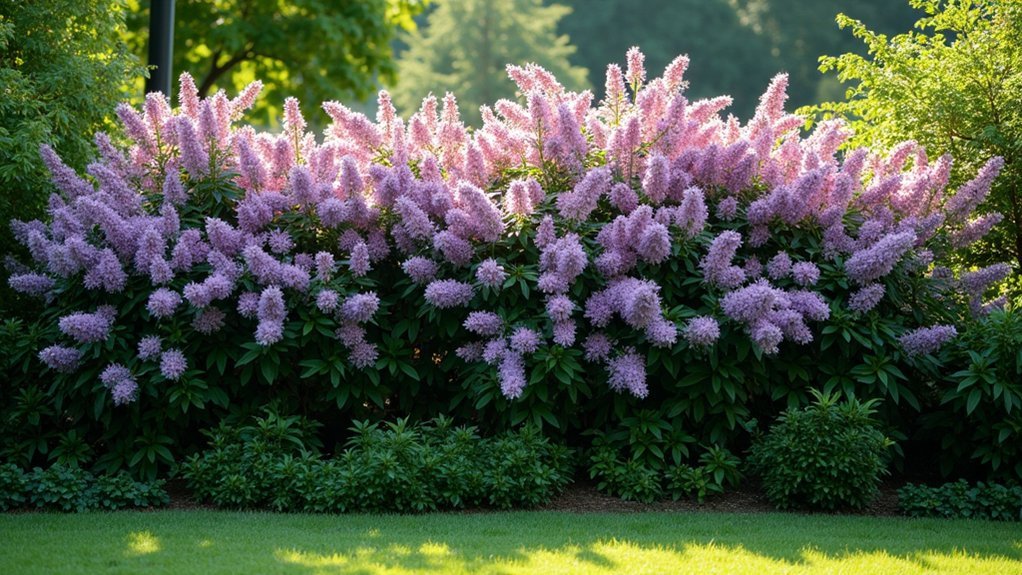
When selecting flowering shrubs for privacy screens, your geographic location plays an essential role in determining which varieties will thrive. Climate conditions directly impact growth patterns, blooming cycles, and overall health of your privacy hedge.
For best results, choose plants specifically suited to your region:
- Warm, sunny areas benefit from Cherry Laurel and Portuguese Laurel, which offer fast growth, seasonal white flowers, and dense screening properties.
- Cool, shady locations call for Boxwood or Rhododendron, providing year-round foliage and vibrant spring blooms.
- Coastal environments require salt-tolerant options like Bayberry or Nellie Stevens Holly, while drought-prone regions thrive with Texas Sage or Italian Cypress.
Cold climate gardeners should consider hardy varieties like Arborvitae or Red Twig Dogwood that withstand freezing temperatures while maintaining their screening function. For seasonal interest, Hydrangeas provide both privacy and spectacular blooms that change color throughout the growing season.
Pruning Strategies to Maintain Dense Coverage
Proper pruning forms the backbone of any successful privacy screen, transforming ordinary flowering shrubs into dense, living walls that protect your outdoor space.
Time your pruning carefully—spring bloomers should be trimmed after flowering, while summer and fall bloomers respond best to late winter pruning.
Timing is everything—prune spring bloomers post-flowering and winter-trim summer/fall varieties for optimal results.
For maximum density, remove dead or diseased branches and maintain a tapered shape with the base wider than the top. This guarantees light reaches all parts of the plant. Thinning out crowded interior branches improves air circulation and helps prevent disease issues in your privacy screen.
Sharp, clean tools make precise cuts that heal quickly and reduce disease risk.
Train young shrubs by heading back new growth to encourage branching from the bottom up. During the growing season, pinch shoot tips to stimulate density.
Complement your pruning with regular watering, mulching, and appropriate fertilization to support vigorous, dense growth.
Soil Preparation for Optimal Growth of Privacy Hedges
Before planting your privacy hedge, you’ll need to test soil nutrients to determine exactly what amendments your chosen shrubs require.
You can improve poor drainage by creating raised beds or incorporating plenty of organic matter like compost or well-rotted manure.
These drainage solutions matter greatly as most flowering shrubs used for privacy screens won’t thrive in waterlogged conditions. For flowering shrubs like azaleas and dwarf fothergilla, ensure you have acidic soil to promote healthy growth and vibrant blooms.
Nutrient Testing Essentials
The foundation of a thriving privacy hedge begins underground with extensive soil testing.
You’ll need to collect multiple soil samples from 6-8 inches deep across your planting area, using clean tools and plastic containers to avoid contamination. Mix these thoroughly before sending to an agricultural extension service or using a home testing kit.
Your soil test will reveal critical information about:
- pH levels that affect nutrient availability (aim for 6.0-7.0 for most flowering hedges)
- Macronutrient levels (N-P-K) needed for leaf growth, root development, and disease resistance
- Secondary nutrients and micronutrients that may require supplementation
Test your soil every 3-5 years and avoid sampling within two weeks of fertilization for accurate results.
These insights help you target amendments precisely, saving money and protecting the environment.
Adding organic matter to your soil significantly improves water infiltration and nutrient availability for your privacy hedge plants.
Drainage Solutions Matter
While nutrient balance sets the foundation for your privacy hedge, what happens to water in your soil can make or break your living screen. Excess moisture leads to root rot and stunted growth, especially in clay soils that retain too much water.
Consider elevating your planting beds by a few inches to improve drainage and protect roots from standing water. For naturally wet areas, choose less aggressive, shallow-rooted varieties like boxwoods, hollies, and “Emerald Green” arborvitae that won’t suffer in heavier soils.
Incorporate organic matter to improve soil structure and permeability. Rain gardens placed strategically near your privacy screen can collect runoff, reduce pollutants, and support local wildlife while managing moisture levels. Proper drainage planning helps prevent damage to foundations when installing privacy hedges near your home’s perimeter.
Native shrubs typically adapt better to your local drainage conditions and require less intervention.
Wildlife-Attracting Privacy Shrubs for Eco-Friendly Yards
Creating privacy in your yard doesn’t mean sacrificing ecological value. Fast-growing shrubs like privet and alder can establish screens quickly while supporting local wildlife.
Privet forms dense thickets for bird nesting, while alder’s rapid growth makes it perfect for wet areas where it supports aquatic insects.
Consider these wildlife-friendly options for your privacy screen:
- Berberis (barberry) offers thorny year-round protection for birds while producing berries that attract seed-dispersing wildlife.
- Hazel provides winter catkins and autumn nuts, feeding everything from squirrels to woodpeckers.
- Yew creates dense evergreen cover with red arils that feed birds during harsh winter months.
These shrubs don’t just block unwanted views—they create functioning ecosystems that support pollinators, provide shelter, and enhance your yard’s biodiversity.
Frequently Asked Questions
How Do Flowering Privacy Shrubs Affect Home Security?
Flowering privacy shrubs enhance your home’s security by creating thorny barriers, blocking intruders’ views, defining boundaries, and deterring trespassing. They’ll also complement other security measures while adding beauty to your property’s protective perimeter.
Can Flowering Privacy Shrubs Damage House Foundations or Underground Pipes?
Yes, they can. Without proper placement, flowering shrubs’ roots may invade foundation cracks or dry out soil, causing shifts. You’ll want to install barriers and choose shallow-rooted varieties to protect your home.
Are There Non-Invasive Alternatives for Areas With Strict Invasive Species Regulations?
Yes, you’ll find plenty of non-invasive alternatives in regulated areas. Consider native options like rhododendron, viburnum, spicebush, redbud, and certain holly varieties that provide privacy while complying with local invasive species laws.
How Do Privacy Shrubs Impact Property Value Compared to Fencing?
Privacy shrubs can increase your property value by up to 20%, often outperforming fences. You’ll benefit from their aesthetic appeal, natural beauty, and evolving character that buyers typically find more attractive than static fencing.
What Privacy Shrubs Work Well in Containers for Apartment Balconies?
For your balcony privacy in containers, you’ll love dwarf lavender, juniper, verbena, and star jasmine. They’re adaptable, don’t need much maintenance, and offer beautiful blooms while creating a natural screen.
In Summary
You’ll transform your yard with flowering privacy shrubs that serve multiple purposes – creating boundaries while adding beauty and ecological value. By selecting varieties that bloom in different seasons and match your climate, you’ll enjoy year-round interest and dense coverage. Don’t forget proper soil preparation and regular pruning to keep your living screen thriving. With these strategies, you’re not just gaining privacy, you’re creating a vibrant landscape sanctuary.

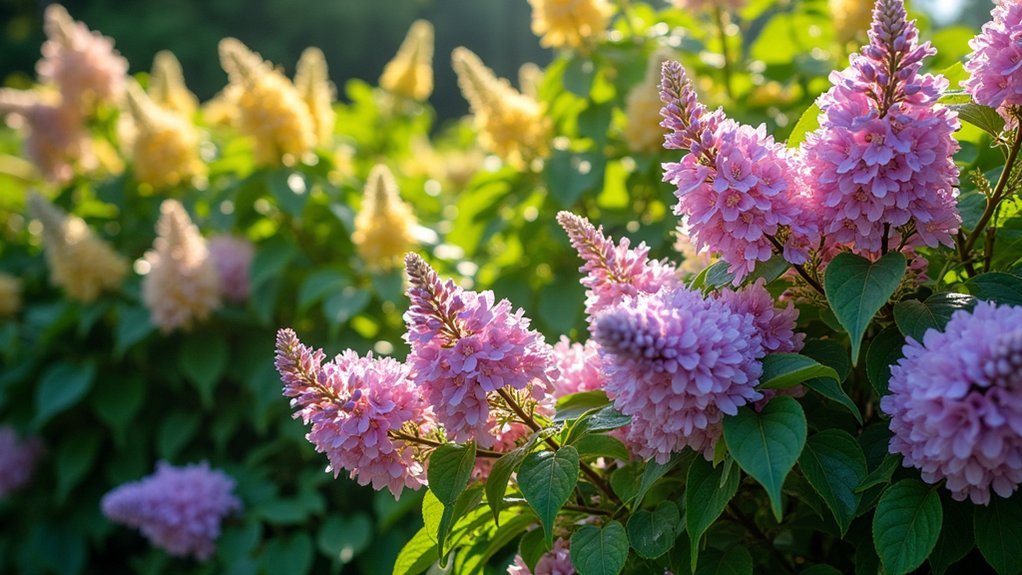



Leave a Reply